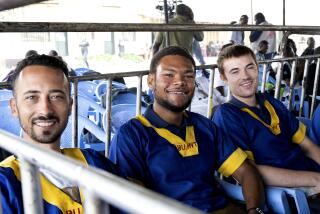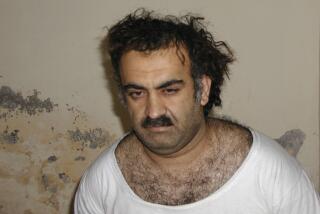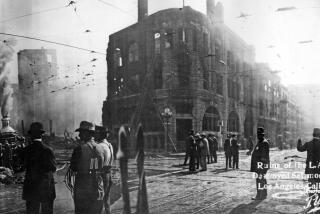4 Guilty in 1998 Terrorist Blasts at U.S. Embassies
NEW YORK — A federal court jury convicted four followers of Islamic militant Osama bin Laden on Tuesday in the bombings of two U.S. embassies in East Africa in 1998 that killed 224.
The almost simultaneous attacks on the diplomatic facilities in Nairobi, Kenya, and Dar es Salaam, the capital of Tanzania, were part of what prosecutors said was a worldwide plot to murder Americans. More than 4,500 were injured, many seriously, in the massive explosions.
The jury of seven women and five men, whose identities were kept secret, convicted all four defendants of conspiring to kill U.S. citizens. The verdicts on the 12th day of deliberations were the first conviction in an American court of people who killed U.S. citizens abroad in a terrorist bombing.
The carnage, which included a dozen Americans, was underscored in the heavily guarded courtroom as the name of each victim--a separate count in the indictment--was read aloud Tuesday.
“Guilty,” the forewoman of the jury repeated over and over in a liturgy of the dead.
“Let me summarize,” said U.S. District Judge Leonard B. Sand when the reading of the complex 302-count verdict finally was completed after more than an hour. “You have found all of the defendants guilty on all the counts. . . . You have more work.”
Starting today, the penalty phase of the trial will begin.
Jurors will consider whether Khalfan Khamis Mohamed, a 27-year-old Tanzanian, and Mohamed Rashed Daoud al-’Owhali, 24, of Saudi Arabia, should be executed or receive life in prison.
The two were convicted of conspiracy and murder. The jurors found that Al-’Owhali participated directly in the Nairobi attack and that Mohamed took part in the Tanzanian bombing, purchased equipment and helped load on a truck the explosive destined for the embassy.
Both were convicted of using an explosive to cause mass destruction.
Two other defendants, Wadih El-Hage, 40, a naturalized U.S. citizen born in Lebanon and living in Arlington, Texas, and Mohamed Sadeek Odeh, a 35-year-old citizen of Jordan, face life in prison without parole.
The defendants--all of whom will appeal--showed little emotion when the verdicts were announced. Odeh took notes. Al-’Owhali chewed on a pen and looked at court papers. But family members of the victims wiped away tears.
“Justice was done,” said Ellen Bomer, a career federal employee who was blinded in the Nairobi blast and who sat in the courtroom crowded with victims during the verdict. “It was the sound I wanted to hear.”
Bomer said that Handel’s “Messiah” went through her mind as the words guilty rang out. “If I could sing, I would have shouted ‘Hallelujah!’ ” she said.
“It was bittersweet,” said Edith Bartley, whose father, Julian Bartley Sr., the embassy’s counsel general, and his son Julian Jr. perished in the Nairobi embassy. “ . . . We hope the law will continue to be on our side.”
“It does not erase the pain,” added Clara Aliganga, whose 21-year-old son, a Marine guard, also was killed in Nairobi. “I would not wish this agony on anyone.”
Bin Laden Among Those Still Sought
So far, 22 have been indicted in the embassy plots. The list includes Bin Laden and a dozen other fugitives. Authorities believe the Saudi millionaire is being protected by the Taliban regime in Afghanistan.
“Today’s guilty verdicts are a triumph for world justice and for world unity in combating international terrorism,” said U.S. Atty. Mary Jo White, whose office prosecuted the case. “ . . . But our job is not finished.”
The trial provided the most complete portrait outside of secret intelligence files of al Qaeda (The Base), Bin Laden’s terrorist organization.
Prosecutors introduced testimony from dozens of witnesses during the three-month trial, including several al Qaeda defectors. The government, aided by documents and photographs, dissected the group’s aims, organization, operating methods and business ventures.
Behind a front of businesses used to disguise terrorist activities and to funnel money to operatives, al Qaeda’s organization chart consisted of a number of committees, including a military committee, a business committee and a media committee reporting to a Shura Council of leaders.
Hundreds of thousands of pages of material were used to prepare for the trial, underscoring the magnitude and complexity of the investigation.
Barry W. Mawn, assistant FBI director in charge of the New York field office, said the investigation represented the largest FBI deployment abroad ever.
The chain of evidence began in guest houses in the late 1980s in Afghanistan and Pakistan, where Bin Laden decided to export Islamic Jihad. It stretched to Sudan, Somalia, Europe and the United States, ending in the smoking wreckage of the two embassies in Africa in August 1998.
“This wasn’t an attempt to get on the Fortune 500,” Assistant U.S. Atty. Kenneth Karas said in closing arguments, outlining al Qaeda’s aims. “This wasn’t Money Incorporated, ladies and gentlemen. This was about Jihad Inc.”
The most poignant testimony came from the survivors, some of them blinded when the massive bombs exploded. Still shaken more than two years later, they relived scenes of death, horror and heroism.
Court attendants helped Pinanah Muholo to the witness stand. In a soft voice, she told the jury she had lived in Kenya her whole life. She said the bus she was riding stopped near the U.S. embassy.
Muholo watched a pickup truck approach the embassy compound, someone get out and hold something in both hands. There was a lot of noise, Muholo said, and then a huge explosion.
The man and the truck were the last things she saw.
“I lost my eyes,” she said.
Prudence Bushnell, currently ambassador to Guatemala, and the top U.S. diplomat in Kenya at the time of the bombing, provided perhaps the most enduring image of the trial--a teacup.
She was meeting in a nearby bank building with Kenya’s trade minister and other officials when the bomb went off. After regaining consciousness, she found she was sitting with her hands over her head.
“I will never forget the rattling of a teacup. [It] just kept rattling,” she said.
“There was a conspiracy behind these embassy attacks, a conspiracy to murder the people of the United States simply because they were Americans,” Karas said in his closing argument. The prosecutor said that justice was “crying out” for a guilty verdict.
Each defendant was charged in three conspiracy counts: conspiring to murder U.S. citizens, to use weapons of mass destruction against American targets and to destroy U.S. buildings.
In addition, al-’Owhali and Mohamed were accused of conspiring to kill employees of the U.S. government, crimes that could carry the death penalty.
The last time a defendant was sentenced to death in the Southern District of New York, which includes Manhattan, the Bronx and counties north of the city, was in 1957 for killing a federal agent.
Government lawyers charged that plans called for al-’Owhali to die in the Nairobi bombing. After training in terrorist camps in Afghanistan, he received an audience with Bin Laden and asked for a mission.
Before the attack on the embassy, court papers charged, al-’Owhali made a video that was supposed to take credit for his martyrdom.
The morning of the attack, he rode in the bomb truck to the building. Prosecutors said he carried keys to locks in the back of the vehicle. If the detonator failed, his job was to open the locks and throw in grenades to try to set off the explosives that were packed in wooden boxes.
Government lawyers said that as the beige-colored truck approached the embassy, al-’Owhali jumped out and threw stun grenades at the guards before running away. Trying to get closer, the driver started shooting from a truck window before detonating the bomb at 10:35 a.m. He was killed in the attack.
After leaving a trail of evidence, al-’Owhali was captured days later in Kenya.
During the trial, Muwaka Mula, a witness who worked at the embassy, identified al-’Owhali as the man he saw get out of the truck and hurl the stun grenades.
Mohamed was charged with participating in the Dar es Salaam bombing.
According to the government’s case, he bought a white Suzuki utility vehicle used to transport bomb components, including TNT, gas cylinders and detonators. Prosecutors said he rented the house used as the Tanzanian bomb factory and helped load the completed weapon on a Nissan Atlas refrigeration truck.
The morning of the attack, he rode in the truck with the bomb, then got out and went back home, where he listened to news of the blast and prayed for the driver who was killed. He was captured months later in South Africa.
The evidence against Mohamed included his fingerprint on the lease, the bill of sale for the Suzuki, detonators later discovered at the bomb factory and laboratory tests. Karas told the jury when FBI experts conducted tests on the utility vehicle it was as if “someone took the Suzuki and dipped it in TNT.”
During the trial, prosecutors portrayed Odeh as a sworn member of al Qaeda who acted as a planner and technical advisor for the Nairobi bombers.
Prosecutors charged that Odeh traveled to Nairobi before the bombing and, with a false passport, checked into a hotel and attended a meeting with members of the cell. Before fleeing Nairobi the night before the embassy bombings, he shaved his beard so he wouldn’t look like a Muslim.
Odeh was captured at the airport in Karachi, Pakistan. The jury heard testimony from an FBI laboratory technician that some of the clothing Odeh carried when he was arrested tested positive for explosives.
El-Hage, a naturalized U.S. citizen, wasn’t charged as a direct participant in the embassy attacks. Government lawyers portrayed him as a “facilitator” who performed key logistical tasks for al Qaeda and who served as Bin Laden’s personal assistant and “gatekeeper” when the terrorist group had its headquarters in the Sudan.
U.S. Citizen’s Role in Bombings Detailed
Prosecutors told the jury that El-Hage arranged for the delivery of false travel documents and moved to Nairobi in 1994 to become a leader of al Qaeda’s East Africa cell.
In February 1997, he visited Bin Laden after the group had moved back to Afghanistan and returned with orders to “militarize” the cell that would carry out the bombings in Nairobi and Dar es Salaam, government lawyers said.
El-Hage was also convicted of perjury for lying before two grand juries.
Prosecutors charged that El-Hage conducted business transactions while at the same time living a secret criminal life on behalf of al Qaeda.
El-Hage’s lawyers waged the most vigorous defense during the trial, insisting he merely helped Bin Laden with legitimate ventures and did not support murdering innocent people.
Lawyers for al-’Owhali did not dispute that he rode in the bomb truck or tossed stun grenades outside the Nairobi embassy. They said he should be acquitted because statements he made to FBI interrogators were coerced.
Mohamed’s lawyer admitted his client rented the house in Dar es Salaam and bought the Suzuki Samurai. He pictured him as a mere laborer, a pawn in the plot so naive that he had to ask what TNT was.
Lawyers for Odeh in closing arguments pictured him as a “purist” and a simple man whose association with al Qaeda was based on religious beliefs.
*
Times researcher Lynette Ferdinand in New York also contributed to this story.
(BEGIN TEXT OF INFOBOX / INFOGRAPHIC)
The Bombing Defendants
Mohamed Rashed Daoud al-’Owhali, 24, of Saudi Arabia. Arrested five days after the bombings. According to the prosecution, he admitted riding in the bomb vehicle in Nairobi, Kenya, and tossing a stun grenade to distract guards. He could face death.
*
Wadih El-Hage, 40, of Arlington, Texas. Born in Lebanon, he is the only U.S. citizen charged. Prosecutors alleged he was Osama Bin Laden’s former personal secretary. His lawyers claim he worked for Bin Laden only on legitimate business ventures. He could face life in prison.
*
Khalfan Khamis Mohamed, 27, of Tanzania. Known as “K.K.,” Mohamed was accused of riding in a bomb-laden truck to the embassy in Tanzania. He also allegedly rented a house in his native Tanzania that was used as a bomb factory and helped prepare TNT. He could face death.
*
Mohamed Sadeek Odeh, 35, of Jordan. Odeh allegedly told investigators that he went to Kenya five days before the bombings and met a fellow explosives expert for the Kenyan terrorism cell. Prosecutors alleged that he met with Bin Laden on the plot. He faces a potential life sentence.
(BEGIN TEXT OF INFOBOX / INFOGRAPHIC)
Bombing Timeline
Key events in the embassy bombings case:
*
1998: Truck bombs explode Aug. 7 at U.S. embassies in Nairobi, Kenya, and Dar es Salaam, Tanzania, killing 224 people, including 12 Americans. Osama bin Laden is blamed; United States bombs sites in Afghanistan and the Sudan in retaliation.
*
1998-99: Grand jury indicts Bin Laden in embassy bombings, one of 22 suspects eventually named. Thirteen, including Bin Laden, remain at large, but suspects Mohamed Rashed Daoud al-’Owhali, Khalfan Khamis Mohamed and Mohamed Sadeek Odeh are brought to the United States. Wadih El-Hage of Arlington, Texas, is arrested.
*
Jan. 3, 2001: Jury selection begins in trial of Al-’Owhali, Mohamed, Odeh and El-Hage.
*
May 10: Jury deliberations begin.
*
May 29: All four defendants are convicted; two of them, Al-’Owhali and Mohamed, could face the death penalty.
*
Source: Associated Press
More to Read
Sign up for Essential California
The most important California stories and recommendations in your inbox every morning.
You may occasionally receive promotional content from the Los Angeles Times.










